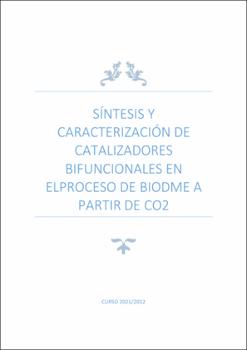Síntesis y caracterización de catalizadores bifuncionales en el proceso de bioDME a partir de CO2
Fecha
2022Resumen
La actualidad está marcada por el contexto de Transición Energética que estamos llevando a
cabo. Esta Transición está basada en los ambiciosos objetivos europeos y las políticas de Cambio
Climático, unos compromisos ratificados por abrumadora mayoría en el Parlamento Europeo y
que cuentan con un fuerte respaldo social. Todo ello con la finalidad de mitigar el calentamiento
global, que consiste en el incremento gradual de la temperatura del planeta como consecuencia
del aumento de la emisión de ciertos Gases de Efecto Invernadero, como por ejemplo el CO2.
Una posible solución para esto podría ser el empleo de CO2 como materia prima para la síntesis
de hidrocarburos, concretamente de DME. Esta se contempla como una de las vías más eficaces
para reducir la concentración de este gas a gran escala. Para realizar esta síntesis de la forma
más viable posible, se busca la síntesis de determinadas estructuras catalíticas donde los
aspectos más importantes a tener en cuenta en su formación son la actividad y la selectividad
del catalizador, donde entra también el grado de acidez y las características estructurales de
distribución y tamaño de los poros. Normalmente, la actividad se incrementa con una mayor
acidez, sin embargo, si esta es demasiado elevada provocaría la conversión del DME en otros
hidrocarburos, por lo que hay que buscar un catalizador adecuado, que ofrezca los mejores
resultados atendiendo a las características anteriores.
Para ello se prueban distintas estructuras catalíticas como son:
• Dos catalizadores tipo hidrotalcitas, Cu:Zn:Al (H-CZA) y Cu:Fe:Al (H-CFA), que presentan
una relación molar de 2:1:1
• Una zeolita tipo AEL (SAPO-11) con tres tiempos de cristalización diferentes (12, 18 y 24
horas)
• Un catalizador bifuncional obtenido por la mezcla de una fase metaliza mixta al 15% en
masa de los metales Cu:Zn, en relación (2:1), con la zeolita SAPO-11 (18 h)
Tras su síntesis, las estructuras fueron sometidas a distintos métodos de caracterización, como
son: difracción de rayos X, espectroscopía infrarroja, microscopía electrónica de barrido y Área
Superficial Específica. Con la finalidad de confirmar que en la síntesis se conseguía la estructura
deseada.
Todos estos catalizadores se prueban en la reacción de hidrogenación de dióxido de carbono,
para el posterior análisis de resultados.
Como resultados más relevantes se obtiene que el catalizador que presento mejor conversión
fue el catalizador bifuncional (10,31%), mientras que el que presento mejor selectividad a MeOH
fue el SAPO-11 (18h) (19,14%) mientras que la mejor selectividad a DME se observó con el
catalizador H-CFA (2:1:1) (7,66%) The current situation is marked by the context of the Energy Transition that we are carrying out.
This Transition is based on ambitious European objectives and Climate Change policies,
commitments ratified by an overwhelming majority in the European Parliament, and which have
strong social support. All this to mitigate global warming, which consists of the gradual increase
in the temperature of the planet because of the increase in the emission of certain Greenhouse
Gases, such as CO2.
A possible solution for this could be the use of CO2 as a raw material for the synthesis of
hydrocarbons, specifically DME. This is seen as one of the most effective ways to reduce the
concentration of this gas on a large scale. To carry out this synthesis in the most viable way
possible, the synthesis of certain catalytic structures is sought where the most important aspects
to consider in their formation are the activity and selectivity of the catalyst, where the degree
of acidity and the structural characteristics of distribution and size of the pores also enter.
Normally, the activity increases with a higher acidity, however, if this is too high it would cause
the conversion of DME into other hydrocarbons, so it is necessary to look for a suitable catalyst,
which offers the best results according to the above characteristics.
To do this, different catalytic structures are tested, such as:
• Two hydrotalcite-type catalysts, Cu:Zn:Al (H-CZA) and Cu:Fe:Al (H-CFA), which have a molar
ratio of 2:1:1
• An AEL zeolite (SAPO-11) with three different crystallization times (12, 18 and 24 hours)
• A bifunctional catalyst obtained by mixing a mixed metallization phase at 15% by mass of
the metals Cu:Zn, in ratio (2:1), with the zeolite SAPO-11 (18 h)
After their synthesis, the structures were subjected to different characterization methods, such
as: X-ray diffraction, infrared spectroscopy, scanning electron microscopy and Specific Surface
Area. To confirm that the desired structure was achieved in the synthesis.
All these catalysts are tested in the carbon dioxide hydrogenation reaction, for the subsequent
analysis of results.
As most relevant results, it is obtained that the catalyst that presented the best conversion was
the bifunctional catalyst (10.31%), while the one that presented the best selectivity to MeOH
was the SAPO-11 (18h) (19.14%) while the best selectivity to DME was observed with the H-CFA
catalyst (2:1:1) (7.66%)





